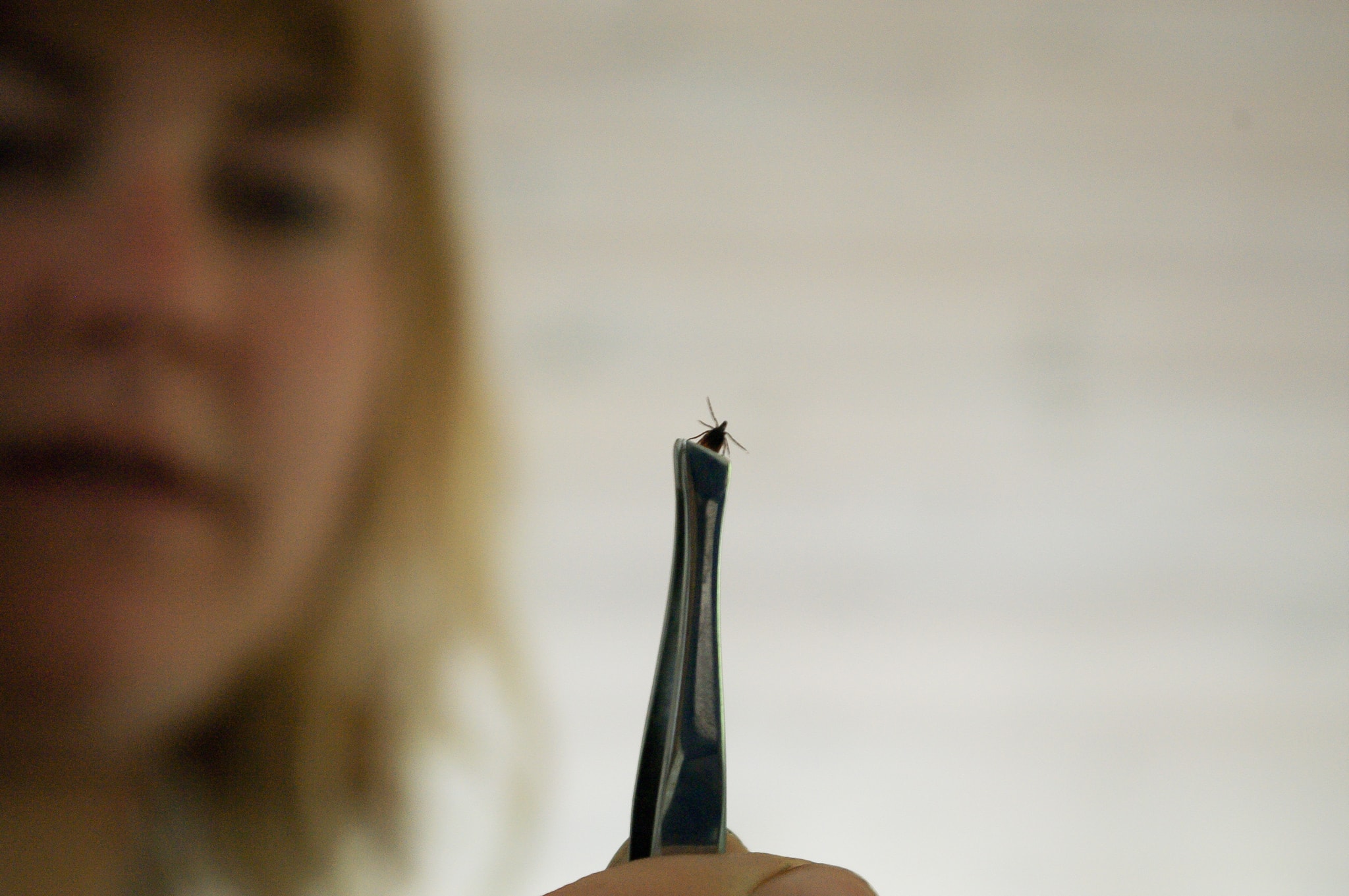Seresto flea collar review: Does it really work?

Yikes! My dog has fleas!
Fleas and dogs go together like peanut butter and jelly, just much less appetizing.
This external pest has been around since the Jurassic Period!
It was most likely causing some itchy problems on our long-lost dinosaur friends, too.
However, unlike millions of years ago, we now have solutions for controlling fleas. One of these is the flea collar.
In this post, we’ll do much more than just “scratch” the surface of flea and tick prevention, including everything you need to know as a dog owner to prevent these nasty creatures. Then, we’ll review one of the most popular brands of flea collars on the market today, the Seresto flea collar.
Plus, we’ll also take a look at the toxic chemicals that can find their way into those inferior flea collars that you will certainly want to avoid.
Seresto flea collars, does it really work? The short answer is, yes! We highly recommend it, and you can get the Seresto flea collar on Amazon.
Fun flea facts
Before we wage war on the flea, let’s get to know our enemy a little better with these fun flea facts.
Did you know…
- The most common flea is the Ctenocephalides felis or the “cat flea” which can be found throughout Canada and the United States.
- There are over 2,000 known species of the flea.
- There are four stages of a flea’s life cycle: Egg, Larvae, Pupae, and Adult.
- One female flea can produce approximately 2,000 eggs over the course of her 2 to 3-month lifespan.
- A female flea needs a blood meal to lay her eggs and she can consume up to 15 times her own body weight on a daily basis.
- The flea can jump 110 times its own length. This is comparable to the average person having the ability to jump over a 30-story building!
- When the flea jumps it will accelerate 20 times faster than the space shuttle.
Region affected by fleas
- Fleas can be found all over the United States and Europe.
- They like warm, humid conditions, so the infestations will typically be worst during mid to late summer and early fall.
- In some parts of the United States, they can be a significant problem year round.
Other Problems
Once fleas have infiltrated your home they can live comfortably well into the winter months if they were able to establish themselves before it got cold.
This could mean trouble for more than just your pets; they can also play a role in transmitting tapeworms and cat scratch fever to humans.
That’s all for fleas right now. Let’s move on to Ticks.
Ticks
While not as annoying due to the fact that they don’t itch, ticks actually pose a far more serious problem than fleas or lice.
Ticks are far more insidious and they fly under the radar. In fact, people often don’t even notice that they have one, which is a serious issue because they can transmit potentially fatal diseases.
Let’s learn more about the most commonly encountered parasites for dogs and humans.
Tick Biology
Ticks are blood feeding external parasites of mammals, birds, and reptiles. They have existed for thousands of years and the scientific community has identified 850 species in the world. They transmit the widest variety of pathogens of any blood sucking arthropod.
What ticks need to survive
Ticks prefer warm and humid climates but continue to survive harsh winters through the parasitic relationships with their hosts.
Ticks need to have a blood meal every so often but they can go for up to 2 months without feeding if environmental conditions allow.
Tick life cycle
- Larva- Tick eggs hatch and become larva. At this stage they only have 6 legs.
- Nymph- After acquiring a host to feed on they molt into the nymph stage and grow 2 legs, having 8 for the rest of their life cycle.
- Adult- After feeding once more they molt again into the adult stage. The fed adult stage is terminal, meaning that once the male has reproduced he dies, and once the female has laid eggs she also dies.
Types of diseases transmitted by ticks
Lyme Disease
Bacterial disease transmitted by the deer tick. A subject is exposed to infection if the tick has been attached for 24 to 48 hours
Symptoms - The first stage is characterized by a rash shaped like a bull’s-eye target. It’s not painful and it does not itch.
It takes several weeks for the bacteria to disseminate, at which point flu like symptoms will occur: Chills, fever, enlarged lymph nodes, sore throat. This is known as stage two.
Stage three can take weeks, months, or years after the initial tick bite and includes the following symptoms: severe headaches, disturbances in heart rhythm, neurological deficits like short term memory loss, and numbness in the arms, legs, hands, or feet.
Treatment - Lyme disease is best treated in the early stages with oral antibiotics. Late stage or chronic lyme disease must be treated aggressively with intravenous antibiotics for a period of 14 to 21 days.
Region - Lyme disease is the most common tick borne illness in Europe and the Pacific Northwest, Northeast, and Upper Midwest regions of the United States.
Ehrlichiosis
A bacterial disease transmitted primarily by the Lone Star tick. A subject is exposed to infection if the tick has been attached for 24 to 48 hours .
Symptoms - Almost indistinguishable from flu symptoms. People sometimes mistake ehrlichiosis for the flu and their immune systems are able to fight it off without much medical attention.
However, if symptoms persist for longer than a normal cold ehrlichiosis can cause complications.
Treatment - Oral antibiotics are usually recommended.
Region - Documented cases of ehrlichiosis have been seen throughout the United States and Europe.
Anaplasmosis
Bacterial disease transmitted primarily by the black-legged tick. A subject is exposed to infection if the tick has been attached for 24 to 48 hours.
Symptoms - Typically begin 1 to 2 weeks after the initial tick bite. They’re similar to that of the flu, and are highly individual ranging from mild to life-threatening depending on the individual.
Treatment - Oral antibiotics are usually recommended.
Region - Common throughout much of the Northern United States but can be contracted anywhere that ticks are found.
Rocky Mountain Spotted Fever(RMSF)
Bacterial infection not transmitted by any particular type of tick.
Symptoms - Symptoms occur 1-2 weeks after the tick bite. Initial symptoms are flu like. 4-5 days after the initial symptoms, the subject will develop a rash that is highly distinctive, hence the name Rocky Mountain Spotted Fever.
If left untreated, Rocky Mountain Spotted Fever can cause serious damage to your internal organs.
Treatment - Antibiotics are usually effective as treatment.
As you can see, ticks pose the greatest threat to humans out of the three common parasites that may attach to your dog.

Ticks lodge themselves into your skin and you have to remove them with tweezers. Image: altemark
What to do if you find a tick on your dog
Ticks are different than fleas in that you or your pet probably won’t get infested by them, and it will probably be one or a few at most. And, unlike fleas, you won’t be able to take medication or apply an ointment to kill them off. With ticks, you’ll have to pull out them out one at a time.
Ticks are part of the arachnid family and genetically speaking they’re closely related to spiders. However, they don’t look anything like a spider, and are a breed of their own.
Ticks wait in trees or bushes for something to brush against them so that they can burrow into a mammal’s skin and suck their blood (gross!). Ticks also have a chemical compound in their saliva that numbs the area they burrow into, meaning that you may not even feel it attach to you.
The worst part is you have to be careful about pulling them out. If you pull too hard, you will only remove their body, which leaves their mouth, the part that can transmit nasty diseases, lodged in whoever was unfortunate enough to brush past one.
The trick with ticks is to pull them out with tweezers gently.
Once removed, dispose of them safely. Ticks have flat bodies and an incredibly hard exoskeleton. You’ll think they’re dead, but they might still be alive.
Tools to remove ticks
If you want special tick removing tweezers the TickCheck kit is a great option. It comes with a pair of tweezers and a remover for adult ticks. You can find the TickCheck kit on Amazon.
Standard fine point tweezers work very well too.
Steps to remove a tick
As I said, prevention is the best medicine, but if you find a tick on your dog before you’ve had a chance to get them a flea collar, here’s what to do:
- Don’t panic. Remember how you have to remove the tick gently? Your dogs take emotional cues from you. Gently lifting the tick will be a lot harder if your dog thinks something is wrong. So stay calm.
- Grab a pair of tweezers.
- Place the tweezers around the most substantial part of the tick and start pulling gently. The tick may actively fight you during this process and, like fleas, they are incredibly strong for their size. Apply steady, constant tension, and it will come out. Patience is key here.
- As soon as the tick comes out, keep a firm hold on it with your tweezers and dispose of it.
- You can dispose of a tick by applyings a flame to it for a few seconds, submerging it in alcohol, or placing it in a sealed bag and throwing it out. Never use your fingers to crush it!
Take preventative measures so that you never have to deal with these parasites again! The process to remove ticks from yourself or another human is the same.
Things to avoid while removing a tick
- Pulling it out with your fingers
- Jerking the tick away
- Burning it while still lodged in you or your dog
- Using chemicals while still lodged in you or your dog
Doing any of those mentioned above could result in the tick vomiting (yes, they can do that) into the wound or otherwise squeeze fluids back into the wound, neither of which you want.
After removal
After removing the tick you will want to clean the area with rubbing alcohol and apply disinfectant ointment after. This will help the area heal and keep it from getting further infected.
I have spent thousands of hours outside with my beloved dog and have pulled a tick out of my leg with a pair of regular tweezers. But I’ve never found one on her. I wish there was a tick collar for humans!
Keep your canine safe while they play outdoors. Image: Jeremy Bronson
Lice
Lice, or as it’s known in dogs, Canine Pediculosis, is the least common infestation you will encounter as a dog owner.
However, they’re the most annoying. Lice can reproduce and spread like wildfire.
Let’s go ahead and learn about the only organism that I’m aware of that has the power to make an entire classroom of elementary school children shave their heads!
Keep in mind, humans can’t get dog lice and dogs can’t get human lice, so there is no fear of crossover from your dog to the rest of your family. However, this is still a pest you’ll want to treat for immediately.
These little parasites chewing on your canine’s skin will cause a lot of discomfort for them.
Lice biology
There are two types of lice.
- Trichodectes canis is the type of lice that chews the skin of the dog it’s infesting
- Linognathus setosus is the type of lice that sucks the blood of the dog it’s infesting.
How do dogs get lice?
Dogs contract lice directly from other dogs or from things that other dogs have touched. They’re most common in areas with a high concentration of canines living in less than sanitary conditions. Some places you should be aware of are kennels, pet stores, and puppy mills.
How do you know if your dog has lice?
These pests are visible to the human eye and appear as tiny black bugs on the dog’s skin. The eggs that they lay are called nits and appear as clusters of white flakes. Manually examining your dog with a combo is the best way to check for them (make sure to wash your hands after.) You can also bring your pooch to the Vet where they can give you a proper diagnosis.
Symptoms of lice
Here are some symptoms to look for if you suspect your canine is carrying lice.
- Hair loss
- Excessive scratching
- Sores on the skin
- Dry Coat
Treatment
You can successfully treat lice with insecticide shampoos.
Bath your dog thoroughly before applying the medication which kills the adult lice.
Repeat the process one week later to kill any lice that hatch in that time.
Do this for all of the dogs in your house at the same time, unless they are on different treatment schedules and continually reinfect each other.
Also be sure to wash everything the dog has touched, including:
- Bedding
- Toys
- Brushes
- Furniture or bedding
Prevention instead of treatment
As is the case with all of these parasites, lice prevention is far less of a hassle for you and far less suffering for your dog. Take precaution and always check your dog after they’ve visited an area they might encounter one of these terrible pests.
Now that we’ve covered some interesting facts on fleas and ticks let’s learn about the chemicals that kill them.
Toxic chemicals to avoid in flea collars
There are four stages of a flea; the egg, the larvae, the pupae and the adult.
Flea treatments kill any one or all of the stages of the flea’s life cycle. For this reason, manufacturers choose very specific chemicals.
However, some chemicals prove toxic to both pets and humans.
According to the Pesticide Research Institute, we should avoid the following toxic chemicals that can be found in some brands of flea collars.
Amitraz
Amitraz is a chemical for use in both spot-on treatments and flea collars. This chemical is a possible carcinogen and can affect the endocrine system of pets such as the ovaries, testes and several glands.
Chemicals in the Carbamates family (Propoxur, Fenoxycarb, Carbaryl)
Found in flea collars, dust, dips, and sprays, these chemicals are toxic to the nervous system of pets, people, and bees. All three of these chemicals are considered to be possible carcinogens.
In addition, the residue left on the pet’s fur from collars containing Propoxur pose a particular risk to children and animals.
Organophosphates (Tetrachlorvinphos (TCVP))
Commonly found in flea collars, sprays, and powders, this chemical is highly suspected to be a carcinogen, and can be toxic to the nervous and endocrine systems of pets and people.
These are the most common toxic chemicals you should avoid in your dog’s collar. Now let’s cover some safe and effective options to get rid of those pesky fleas.
Flea’s are the last thing you want to worry about while your dog is playing outside! Image: Bad Apple Photography
Seresto flea collar is safe and effective
Manufactured by Bayer, the dog collar uses two active ingredients that work in combination with each other to deliver protection against both fleas and ticks for up to 8 months.
The two active and safe pesticides in the Seresto flea collar are:
Imidacloprid (10%)
This chemical mimics nicotine, the same one found in tobacco, and is highly toxic to sucking insects.
It’s a common ingredient in over 400 pets, garden, and home products. You can purchase it in powder, liquids, granules and even packets that dissolve in water.
How does Imidacloprid work?
Once the insect has ingested this chemical it goes to work to shut down the nervous system by stopping the individual nerves from sending signals.
This chemical is highly toxic to insects because it binds much better to the receptors of the flea’s nerve cells than it does to mammals or birds.
In flea collars, it works against both the larvae and adult stages of the flea and even lice.
The other good news is according to the EPA (Environmental Protection Agency) there has been no evidence in their tests that suggest Imidacloprid is a carcinogen.
Flumethrin (4.5%)
The second active ingredient in the collar is Flumethrin which works to kill and repel ticks in the nymph, larvae, and adult stages by shutting down the central nervous system of the parasite.
Even though it does belong to the α-cyano-pyrethroids family (a pesticide) the low dose found in the flea collar doesn’t pose a risk to either dogs, cats or people.
A study published in Parasit Vectors found Seresto’s flea collar to be safe and effective on 10-month-old kittens.
Cats contract fleas easier than dogs and the majority of dog flea cases are of the cat flea variety. This lead researchers concluded that if it worked on kittens, then it would be even more useful for canines.
How does the Seresto collar work?
Here’s a quick video that explains more about how the collar works:
The partnership of the two active ingredients forms a synergistic action stored inside the innovative “polymer matrix” of the flea collar. The middle layer of the collar contains the highest concentration of the two ingredients.
As the molecules move towards the surface of the flea collar, their concentration levels lower to form a microlayer. The ingredients then release onto your dog after their hair/skin makes contact with the microlayer, spreading the treatment over your dog’s entire body.
The medication needs some time to build up, so your dog will start receiving protection from fleas and ticks within 48 hours. However, some people have found that it takes longer. I would recommend putting the collar on a week or so before tick season starts or before you would like your dog to be protected, just to air on the safe side.
Of course, as with any chemical, the effects will eventually wear off. The other flea prevention options require you to re-apply the medication. This is why the Seresto flea collar slowly releases the chemical properties to supply your dog with continued protection against these biting pests for up to 8 months.
It is also water resistant, so it will continue to work even when your dog goes swimming or is out in the rain.
This highly innovative and the safe flea collar has been taking the flea treatment market by storm. It’s currently leading the pack for safe, effective flea and tick protection.
You can read more reviews and purchase the Seresto collar on Amazon.
Alternatives in flea prevention
I cannot stress enough just how much easier it is to prevent fleas, ticks, and lice than it is to deal with treating them after the fact.
The Seresto flea collar is far and away the easiest and most robust method of flea prevention. However, there are other options you should be aware of. One of them that is relatively easy and effective is Frontline.
Frontline is a well known brand of flea and tick treatment that you apply to the dogs fur just behind the neck. It’s an ointment and you have to reapply it once a month because it wears off. If you forget, your dog will be vulnerable to flea infestation until you re-apply the ointment.
Additionally, Frontline only saves you money if you live in a cold climate where the tick and flea season only lasts a few months. Otherwise you’ll want your dog protected for longer than that.
If you live in a colder climate, are willing to deal with monthly reapplication, and want to save money you can read more reviews and purchase Frontline on Amazon.
However, Frontline uses a different mix of chemicals than Seresto, and according to some reviews, it does not appear to be as effective, especially if your dog is particularly prone to fleas and ticks or you live in an area where they are prevalent.
The Seresto collar is a little more expensive but you’re saving yourself the time and pain of having to reapply the medication. For this reason we recommend the collar over the ointment option.
Flea collars and your dog
The best way to combat a flea problem is to prevent it from ever happening.
These pests can be extremely difficult to get rid of so it makes the most sense to put in the effort to prevent them from ever taking hold in the first place.
As Benjamin Franklin once said, “an ounce of prevention is worth a pound of cure,” and in the case of fleas, ticks, and lice, this is even more true.
Once your pet has been infected, they will probably bring the parasite into your house, and whatever your pup was able to rub their furry coat against now is a target for to carry fleas. This means washing and vacuuming everything that they touched.
This is where a flea collar comes in handy. The product is your first line of defense against these nasty pests. It gives your dog up to 8 months protection, and you can use it in conjunction with other flea treatments like pills.
However, if you have any concerns about flea treatments and your individual dog, don’t hesitate to seek veterinarian advice.
Thanks for reading and good luck fighting those pesky pests!
-Jordan
Resources:
1. https://en.wikipedia.org/wiki/Flea 2. https://www.cdc.gov/ticks/removing_a_tick.html
Feature image by: Wonderlane




